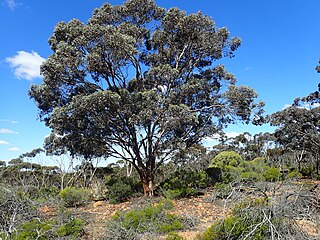
Eucalyptus flavida, commonly known as yellow-flowered mallee, is a species of mallee that is endemic to Western Australia. It has smooth greyish bark, sometimes with rough, flaking brownish bark at the base, lance-shaped adult leaves, long, elongated, tapering flower buds in groups of nine or eleven, yellow flowers and cylindrical or barrel-shaped fruit.
Eucalyptus histophylla is a species of mallee or small tree that is endemic to southern Western Australia. It has smooth bark, often with ribbons of shed bark, linear to narrow lance-shaped adult leaves, flower buds arranged in groups in leaf axils, white flowers and cylindrical to barrel-shaped or conical fruit.
Eucalyptus incerata, commonly known as Mount Day mallee, is a species of mallee that is endemic to southern Western Australia. It has smooth bark, lance-shaped adult leaves, flower buds with a long, horn-shaped operculum and arranged in groups of seven, yellow flowers and barrel-shaped to cup-shaped fruit.
Eucalyptus leprophloia, commonly known as scaly butt mallee, is a species of mallee that is endemic to a small area in Western Australia. It has rough, fibrous bark on the base of the trunk, smooth bark above, lance-shaped adult leaves, flower buds in groups of seven to eleven, white flowers and cup-shaped to barrel-shaped fruit.
Eucalyptus litorea, commonly known as saline mallee, is a species of mallee that is endemic to a small area on the southern coast of Western Australia. It has hard, rough grey bark on the trunk, smooth grey bark above, lance-shaped adult leaves, flower buds in groups of seven, white flowers and cylindrical or barrel-shaped fruit.
Eucalyptus livida, commonly known as wandoo mallee, is a species of mallee or small tree that is endemic to Western Australia. It has smooth bark, lance-shaped adult leaves, flower buds in groups of eleven or more, creamy white flowers and barrel-shaped fruit.

Eucalyptus luteola is a species of mallee that is endemic to a small area of Western Australia. It has smooth grey bark with rough greyish ribbons near the base, linear to narrow lance-shaped adult leaves, flower buds in groups of eleven to thirteen, lemon-coloured flowers and cylindrical to barrel-shaped fruit.
Eucalyptus melanophitra is a species of mallet that is endemic to a restricted area of Western Australia. It has rough, flaky grey bark on the trunk, smooth grey bark above, narrow lance-shaped adult leaves, flower buds in groups of nine or eleven, pale yellow flowers and cylindrical to barrel-shaped fruit.
Eucalyptus obesa, commonly known as the Ninety Mile Tank mallee, is a species of mallee that is endemic to Western Australia. It has smooth, greyish to pale brown bark, usually lance-shaped adult leaves, flower buds in groups of between eleven and fifteen, creamy white flowers and shortened spherical to hemispherical fruit.
Eucalyptus olivina is a species of mallee or a tree that is endemic to Western Australia. It has smooth greyish bark, linear to narrow lance-shaped adult leaves, flower buds in groups of seven or nine, creamy white flowers and short barrel-shaped to cup-shaped fruit.
Eucalyptus pluricaulis, commonly known as the purple-leaved mallee, is a species of mallee that is endemic to Western Australia. It has smooth bark, dull bluish green, lance-shaped leaves, flower buds in groups of between nine and fifteen, pale yellow flowers and cylindrical to barrel-shaped fruit.
Eucalyptus quadrans is a species of mallee or a small tree that is endemic to the southwest of Western Australia. It has smooth, greyish bark, narrow lance-shaped adult leaves, flower buds in groups of seven, white flowers and cup-shaped fruit that are square in cross-section.
Eucalyptus rigens, commonly known as saltlake mallee, is a species of sprawling mallee that is endemic to the southwest of Western Australia. It has smooth bark, lance-shaped adult leaves, flower buds in groups of three on a flattened peduncle and sessile, ribbed fruit.
Eucalyptus subangusta is a species of tree, mallee or mallet that is endemic to the southwest of Western Australia. It has smooth bark, narrow lance-shaped leaves, flower buds in groups of up to nineteen, white flowers and cup-shaped to barrel-shaped fruit.
Eucalyptus thamnoides is a species of mallee that is endemic to south western Western Australia. It has smooth bark, lance-shaped adult leaves, flower buds in groups of seven, cream-coloured to pale yellow flowers and cup-shaped, conical or bell-shaped fruit.

Eucalyptus utilis, commonly known as coastal moort or coastal mort, is a species of mallet or mallee that is native to southern areas of Western Australia. It has smooth bark, egg-shaped to lance-shaped adult leaves, flower buds in group or seven, creamy white flowers and conical fruit.

Eucalyptus captiosa is a species of mallee that is endemic to the south-west of Western Australia. It has smooth bark, lance-shaped adult leaves, groups of three or seven, slightly ribbed flower buds arranged in leaf axils, pale yellow flowers and cup shaped fruit.

Eucalyptus clivicola, commonly known as green mallet, is a species of eucalypt that is endemic to Western Australia. It has smooth bark, linear to lance-shaped adult leaves, flower buds in groups of between nine and thirteen, pale yellow flowers and barrel-shaped, conical or cylindrical fruit.

Eucalyptus densa is a species of mallee or mallet that is endemic to Western Australia. It has smooth greyish bark that is shed in curly strips, linear to narrow lance-shaped adult leaves, long, spindle-shaped flower buds in groups of seven or nine, pale yellow or lemon-coloured flowers and conical, cylindrical or barrel-shaped fruit.

Eucalyptus diminuta, commonly known as the spring mallee, is a species of mallee that is endemic to south-west of Western Australia. It has smooth, silvery to greyish bark, sometimes with rough flaky bark near the base, lance-shaped adult leaves, pendulous, elongated flower buds arranged in groups of seven, creamy white flowers and cup-shaped to bell-shaped fruit.






